|
HOME: www.hiltonpond.org |
|||
THIS WEEK at HILTON POND Subscribe for free to our award-winning nature newsletter (Back to Preceding Week; on to Next Week) |
Come be part of a real citizen-science project. |
AN OWL, SOME FINCHES, At Hilton Pond Center during the last half of July 2016 we banded numerous individual birds but few avian species; in fact, just three. Most encounters were to be expected--as when we trapped the usual hummingbirds and finches--but we also had a very uncommon experience with an owl. If you're curious about any or all of these, please read on. We've been banding Ruby-throated Hummingbirds at the Center since 1984. In the old days, we captured a few hummers in big stationary mist nets used primarily to snare other species. The vast majority, however, we caught in low-tech pull-string traps baited with sugar water. To activate these we tied a fishing line to a swinging trap door and threaded the line through the wall of the old farmhouse so that it ended at our computer desk. (At one time we had nine different traps to keep track of, which meant we had drilled a LOT of holes through farmhouse siding!) When we saw a hummer enter a trap, we reached up and pulled a ring attached to the appropriate string, closing the door quickly but safely. One of those pull-string contraptions has been mounted on the trunk of an Eastern Red Cedar tree for 33 years and has allowed us to snare hundreds of ruby-throats (and two winter vagrant Rufous Hummingbirds) for banding. At about 10 p.m. on 19 July while we were at our desk the pull-string ring started bouncing up and down. This was an odd occurrence, so we immediately grabbed a flashlight and ventured into the darkness to investigate. Imagine our surprise when we found a Barred Owl sitting on the ground with the monofilament wrapped around the tip of one of its long primary feathers, about an inch from the end. The bird jumped at our approach but the line somehow held fast to its feather, preventing escape. By distracting the owl with the handle of the flashlight we were able to grab both its thighs without its talons skewering our flesh, after which we painstakingly unwrapped the fishing line from the flight feather. Remarkably, the feather, wing, and bird were completely undamaged.
All text, maps, charts & photos © Hilton Pond Center We wrestled the squirmy owl into the house where wife Susan Hilton helped find the appropriate band and covered the bird's head. As expected, the owl did a lot of bill clacking and also managed to bite a few bander fingers, breaking the flesh on one of them. (It's understandable why owl banders often have scars on their hands and arms.) Despite a little human blood, we got the band on the owl in short order, made just a few available light photos--we didn't want to fry the bird's retinas with an electronic flash--and took the now-calm creature back outside. There we waited several minutes for its eyes to adjust to the dark, sat the owl on the ground, and felt pretty good when it took off gracefully before landing on a high branch in the nearest big tree. This was only the third Barred Owl banded at Hilton Pond Center in 35 years, the previous two having been adults caught in mist nets in broad daylight. The newest individual is a fledgling from this year, with poorly formed head and facial feathers typical of youngsters (see photo above). And in case you're wondering, we did take down the pull-string to the trap and henceforth will only put it up during daylight. The odds against this bird-snaring fisshing line situation happening again are great, but we don't want to risk even a small chance that another owl might get caught.
All text, maps, charts & photos © Hilton Pond Center And speaking of owl banding, larger owls require a band different from those used for other birds. Most avian species receive a "butt band" in which the band (or "ring," as they call it in Europe and elsewhere) is opened, applied to the bird's exposed tibiotarsus (usually bare lower leg), and closed down so the ends butt together--as in a House Finch's size 1B band (about 3/8" outer diameter) at left above. This configuration is appropriate for songbirds, waterfowl, and just about everything else except birds armed with heavy decurved bills capable of removing butt bands. In the case of most raptors, for example, banders use a "lock-on" band with two flanges, one longer than the other. The bander opens the band, applies it to the leg, and crimps the longer flange over the shorter one, effectively "locking" the band. The 7B lock-on band at center above (about 5/8" OD) is like the one we used on this week's Barred Owl at Hilton Pond. By comparison, 1/8" OD hummingbird bands (above right) are merely tiny, tiny examples of butt bands. By interesting coincidence, three days after our nighttime banding episode with the owl and the pull-string we retrieved a flash card from one of our trail cameras installed at the edge of Wes's Meadow on the north side of Hilton Pond. (The meadow is named for brother-in-law Wes Ballard, who likes the way we maintain an open space in the middle of what was once a dense stand of Eastern Red Cedar trees.) After downloading the trail cam photos we found, predictably, that White-tailed Deer had been grazing the meadow day and night, and that Coyotes and Raccoons were occasional nocturnal visitors. The big surprise came when we closely examined an image snapped at 1 p.m. on 13 July during a cloudless, sunny afternoon when the camera's internal thermometer registered 89° F.
All text, maps, charts & photos © Hilton Pond Center In a corner of the photo was what at first appeared to be a nondescript brown lump--perhaps a cluster of dead leaves that had fallen from a Sweetgum bordering the meadow--but when we enlarged and sharpened the image (above) it was pretty obvious we had camera-stalked a Barred Owl in broad daylight with its wings spread wide against the ground. We had little doubt this bird--usually nocturnal but sometimes crepuscular and even diurnal--was "sunning," a behavior many birds apparently employ as means of getting rid of ectoparasites. Exposure to solar heat and ultraviolet rays is known to kill bird mites and feather lice, and possibly drive out hippoboscid flies hidden in various nooks and crannies of a bird's plumage. The clock in the camera and multiple frames showed the owl was essentially immobile for up to ten minutes, likely long enough to facilitate at least some parasite removal. We've seen everything from Brown Thrashers to American Robins and Northern Cardinals to Carolina Wrens sunning at the Center, but it was a real treat to learn Barred Owls also exhibit this behavior. (NOTE: Since an entire family of Barred Owls inhabits the woods at Hilton Pond, we have no way of knowing whether the individual in the photo above was the one we banded earlier in the week.) All text, maps, charts & photos © Hilton Pond Center HOUSE FINCHES House Finches (HOFI) continued to dominate our banding totals in late July 2016, mainly because this species is having one of its best breeding seasons since our local population first collapsed in the late 1990s. This downturn was undoubtedly due to the double-whammy of West Nile Virus and a highly contagious strain of mycoplasmal conjunctivitis. Our HOFI started rebounding in 2006 and annual banding totals were steady at about 250 for almost a decade. Inexplicably, there was a major dip in 2014 (just 82 HOFI banded) and 2015 (173), but 2016 has shown a major turnaround with a whopping 331 banded through 31 July. Despite this surge, we doubt we will reach our record-breaking total of 715 House Finches banded back in 1992.
All text, maps, charts & photos © Hilton Pond Center The vast majority of this summer's HOFI have been immature birds produced during the current breeding season, including young males that in some cases have already begun to acquire a few of their red feathers (above). CAVEAT: Among House Finches both males and females are brown at time of fledging, and some males do not become fully red until October or November. In summer and early autumn it is incorrect to assume all brown HOFI are female; red ones, of course, are always male (although adult females often have red or reddish-gold rumps, and older females sometimes have a light pinkish wash). All text, maps, charts & photos © Hilton Pond Center RUBY-THROATED HUMMINGBIRDS Ruby-throated Hummingbirds (RTHU) were slow to appear at Hilton Pond Center in 2016, and for a while we were wondering if this would be one of those inevitable cyclic down years that often occur in nature. Our first adult male RTHU did not appear until 5 April--nine days behind our early record of 27 March (in 1991, 2011 & 2014)--and the next one didn't arrive until 23 April. Our first new female showed up at feeders on 21 April, nearly two weeks behind the early record of 8 April 2002. And our first encounter with an "old" ruby-throat banded at the Center in a previous year was not until 24 May, an startling late date when we might expect experienced hummers with prior local experience to be among the first ones seen again. Our ruby-throat rates continued to lag through the spring, but 21 banded by the 30 June was actually right at our 33-year average for that date. July was especially productive with 79 new bandings, bringing the total at month's end to exactly 100--nearly twice the average for that date and 11 birds ahead of our best-ever total through July. This mid-summer flurry of activity represented quite a shift from the year's slow beginning; as July ended we were on pace to break the season high of 246 RTHU set in 2015. We look forward to a three-week period in late August and early September when we traditionally band more than half the Center's Ruby-throated Hummingbirds for the year.
All text, maps, charts & photos © Hilton Pond Center As expected, by the second half of July this year we were seeing a good mix of age and sex classes among ruby-throats at Hilton Pond Center. Interestingly, several adult males already were showing signs of body molt, including replacement of throat and head plumage. The photo above depicts an adult male hummer missing a few red gorget feathers and with new pinfeathers just coming in at the lores (between eye and base of the bill). This molt pattern will continue through migration and on wintering grounds in Mexico or Central America, where ruby-throats replace all their tail and wing feathers before returning north in pristine attire.
All text, maps, charts & photos © Hilton Pond Center By the way, only the adult male Ruby-throated Hummingbird has a forked tail made up of pointed, black-tipped feathers (above). This makes it possible to identify his age and sex from rear view at your feeder or in silhouette when he's perched on an overhanging branch.
All text, maps, charts & photos © Hilton Pond Center Conversely, female Ruby-throated Hummingbirds or any age have rounded tails with more or less rounded feathers, and the outer three on either side have white tips (above). Alas, you cannot use this field mark to safely sex a ruby-throat because young males ALSO have rounded tails and white feather tips.
All text, maps, charts & photos © Hilton Pond Center In early spring, one can safely sex early arriving Ruby-throated Hummingbirds as females if they have white tail tips and white throats (above), but this field mark again fails beginning when the first fledglings leave the nest. Why? Because a percentage of young males--like females of any age--also have white throats! In other words, young male RTHU can look just like females from throat to tail.
All text, maps, charts & photos © Hilton Pond Center That said, it IS possible to age and sex most immature male Ruby-throated Hummingbirds at your feeder in summer and fall--and even on our Central American study sites through early February--if those birds have heavy dark throat streaking (greenish or blackish) and/or one or more iridescent ruby gorget feathers (above). Young males will acquire full red gorgets on their wintering grounds in the Neotropics; upon returning they look like adult males and will be just that--ready to get down to business courting and mating with receptive females. As July 2016 progressed we saw more and more immature male ruby-throats, which was not a surprise. Through the years young males have made up 42.1% of all RTHU banded at Hilton Pond Center, with immature females comprising 28.6% of the overall population. (Adult males are least represented at 12.7%, a matter for discussion at some later date.) All text, maps, charts & photos © Hilton Pond Center
All text, maps, charts & photos © Hilton Pond Center POSTSCRIPT: After we had already written the above account and prepared to post it, Hilton Pond Center hosted a Guided Field Trip and Hummingbird Banding Workshop for members of the Katawba Valley Land Trust. Participant Doug Barnes came with camera and a keen eye and captured the image above of a Carpenter Ant worker strolling past a diaper pin on which we store hummingbird bands for safe-keeping. We couldn't resist including Doug's photo as yet another way of demonstrating just how small a hummingbird band really is. All text, maps, charts & photos © Hilton Pond Center 
Checks can be sent to Hilton Pond Center at: All contributions are tax-deductible on your |
|---|
|
"This Week at Hilton Pond" is written and photographed by Bill Hilton Jr., executive director of Hilton Pond Center for Piedmont Natural History
|
|
|
Please refer "This Week at Hilton Pond" to others by clicking on this button: |
Comments or questions about this week's installment? Send an E-mail to INFO. (Be sure to scroll down for a tally of birds banded/recaptured during the period, plus other nature notes.) |

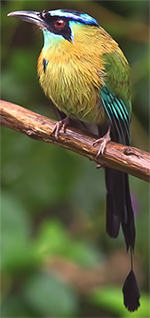 WHEN IT'S DREARY & COLD
WHEN IT'S DREARY & COLD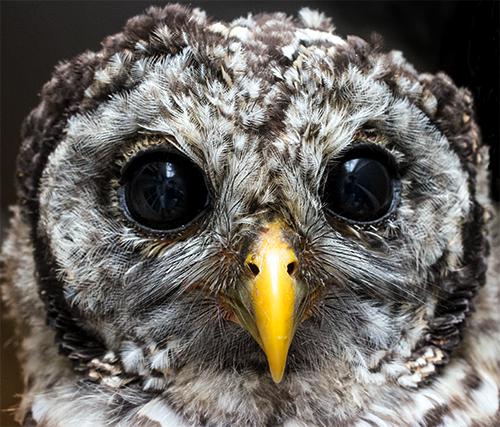

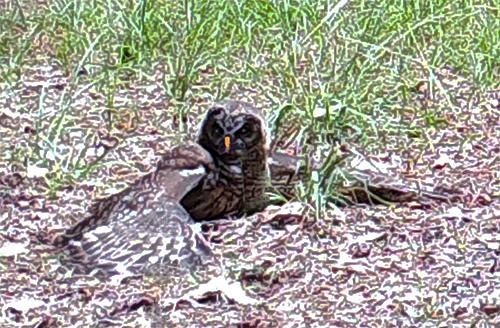
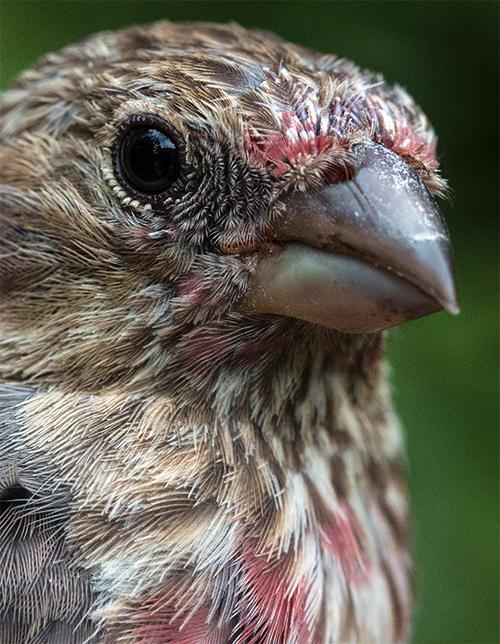
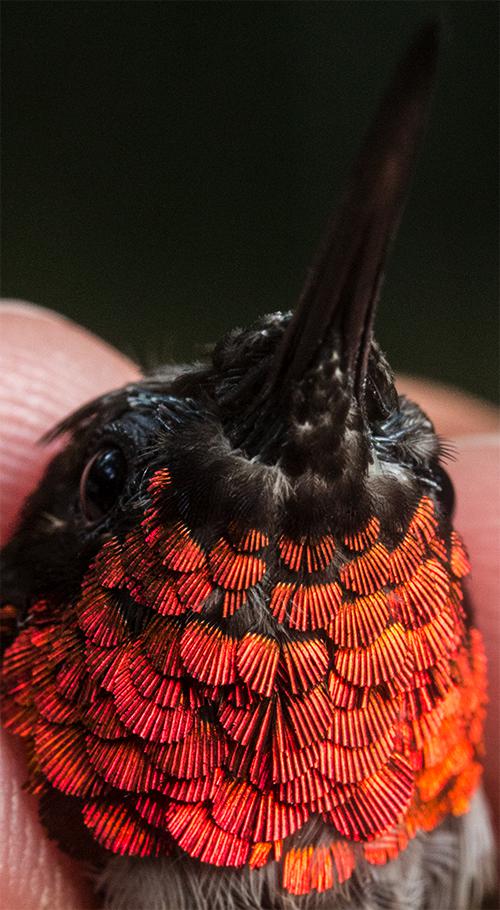

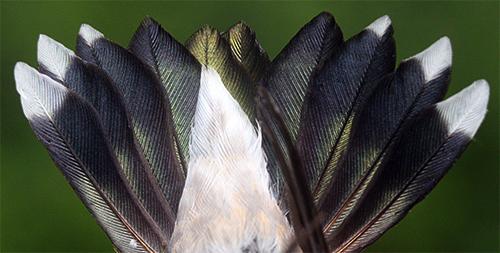
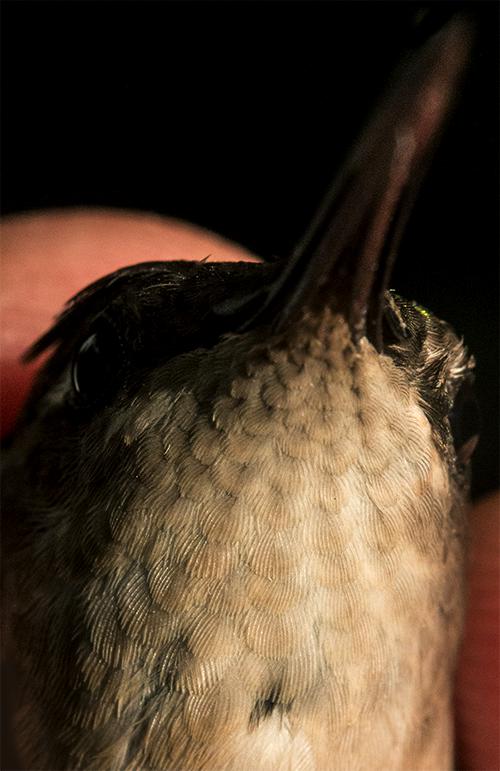
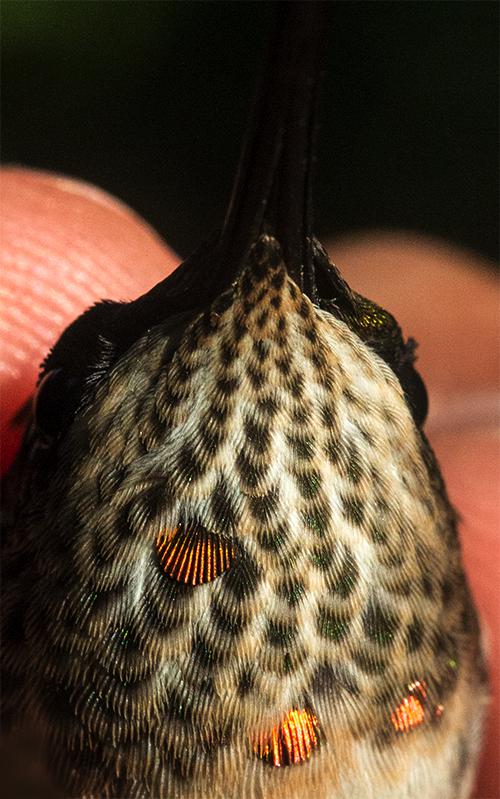
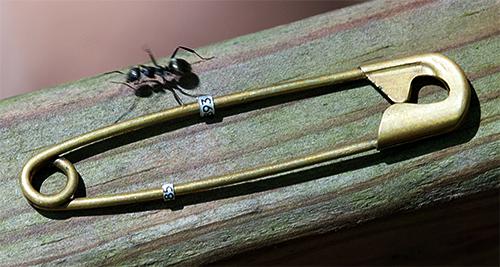








 Please report your spring, summer &
Please report your spring, summer &